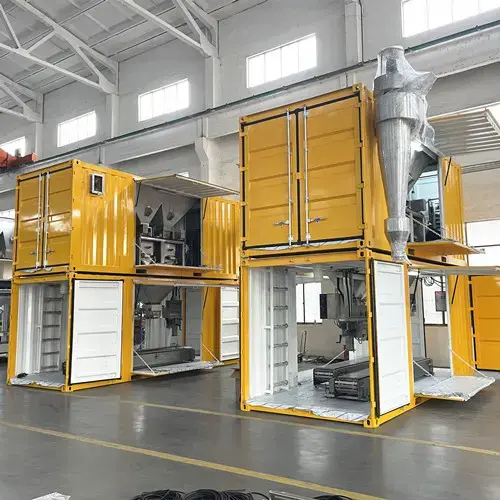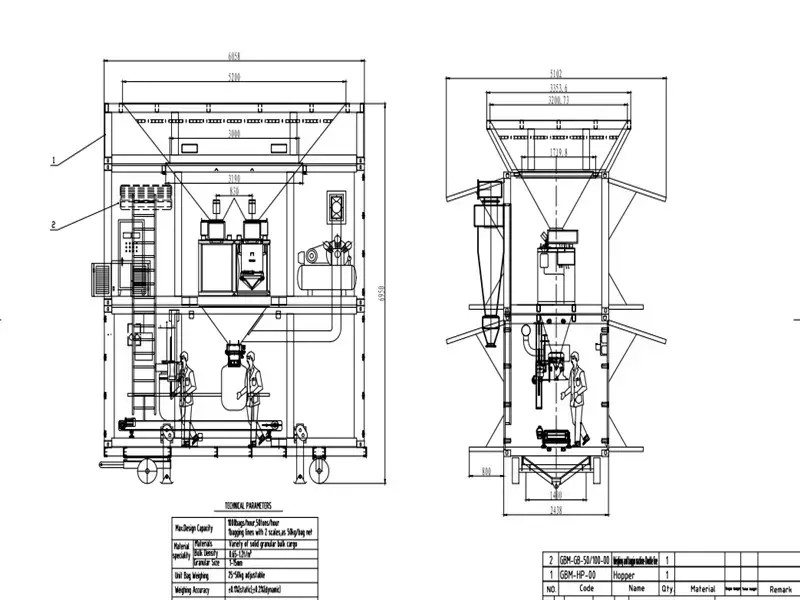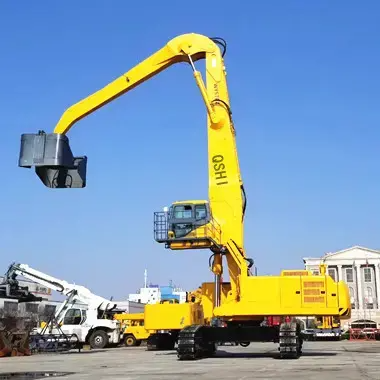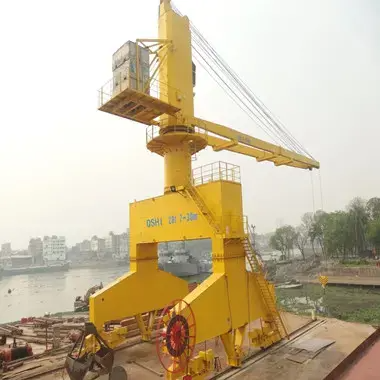
PRODUCTS
Description

LCS-50kg series is a programmed electromechanical machine with following benefits:
▲Combine an automatic weighing unit, a packing unit, a conveyor and a sewing unit. The structure is compact and reasonable. The appearance is fashionable and attractive. Generate a low noise level and save the energy. It is also easy for operation. So, it is able to increase the production efficiency, reduce the labor intensity and improves the working environment.
▲Relying on the high-speed weight data sampling, the automatic compensation, the auto-zeroing, the net-weight metering and other technologies, the machine realizes the accurate metering, the stable and reliable running, the long service life and the outstanding cost performance.
▲Use the digital filtering and the analog filtering technologies to eliminate the effect of mechanical vibration, material impact and other factors on the operating speed and accuracy.
▲The multi-function display, fault monitoring and self-test technologies and several data communication ports (to connect the computer or printer) facilitate the local control and the centralized control.
▲The full-enclosure design reduces the dust corrosion and disturbance, provides better working environment and extends the service life of machines.
▲The weighing hopper is equipped with 3 load cells in a balanced circuit and an enclosure.
▲The electrical system is structured simply. Use the weighing display and PLC for control. Do not use any relay or other electronic components except for switch indicator and electromagnetic counter. Such structure lowers the failure rate considerably, promotes the reliability of control circuit and facilitates the repair. The electromagnetic counter is used to prevent the data loss in case of power interruption.
It has been proven that the machine boasts the quick speed, the high accuracy, the good corrosion resistance, the strong immunity from interference and other features. As for comprehensive performance index, the machine is comparable to foreign competitors.
- Main specifications and technical parameters
2.1. Main technical parameters
▲Accuracy: 16-bit AD conversion (100 cycles/ s)
Measuring accuracy: 0.1%
Control accuracy: 0.2%
▲Weighing range: 25kg -50kg
▲Packing speed: 1800-2000 bags/h (4 scales running in two lines)
Note: The packing speed depends on properties of materials. If a higher speed is requested, we are able to customize the machine.
- Working conditions
▲Wet and dusty outdoor environment
▲Temperature range: -20℃-+45℃
▲Relative humidity: <95% (no condensation)
▲Wind speed: < 20m/s (outdoors)
▲Working system: 24h continuously
▲Power supply: 220VAC, 50Hz
▲Air supply: 0.4-0.6 Mpa, 0.1m3/min
- Working principle
3.1 Principle drawing
3.2 Brief description of working principle
In the automatic running mode, the control system opens the feeder. When the preset value of quick feeding is reached, stop the quick feeding and activate (or maintain) the medium feeding. When the preset value of medium feeding is reached, stop the medium feeding and activate (or maintain) the slow feeding. When the preset lead is reached, stop the slow feeding. The instrument will judge if the package weight is stable. By then, a weighing cycle completes.
A scale with hopper or multiple hoppers (named to the number of equipped weighing hoppers that receive materials from a feeder, weigh materials and discharge materials into a bag via discharge gate). When the level sensor on the storage bin detects a level (upper level or lower level), a feeder starts working (materials fall under the effect of gravity and a single frequency variable screw/double screws/ belt operates). Stop feeding if the weight presetting is reached. After receiving the bag clamping signal, a control instrument sends a signal to open the discharge gate of weighing hopper. Materials flow from the weighing hopper to the bag. The discharge gate is closed automatically. When the control instrument receives the discharge gate closing signal (feeder restarts), the bag clamping unit releases the bag and the conveyor delivers the bag to the sewing machine and following stations. Such cycle is continuous and automatic.
- Basic structure
- 4.1. Mechanical structure
The mechanical part consists of a material bin, a feeder, a frame, a weighing hopper, a guide hopper, a bag clamping unit, a sewing machine, a column of sewing machine and a chain conveyor (as shown).
4.1-1 Material bin
The material bin is a buffer bin. It is used to store materials and provide a relatively uniform material flow. A level sensor on the bin will detect if there are sufficient materials. To feed material uniformly and stably, the feeder will work only when the quantity of stored materials is two times than the package weight. Additionally, a manually-operated gate valve is equipped to adjust the material flow rate and prevent materials in the bin to apply a force on scales. It can also be used during maintenance, repair or emergency.
4.1-2 Feeder
The feeder is structured into a two-way arc gate. Materials flow under the gravity. Adjust the gate opening with two-stroke cylinder to accomplish the quick and the slow feeding. Change the size of quick or slow feeding outlet with regulating bolt at the end of pneumatic control cabinet. (The size of quick feeding outlet and that of slow feeding outlet can be adjusted separately.) Both outlets can be adjusted 100% at most. Furthermore, you can modify the preset value to obtain the optimum ratio of quick feeding to slow feeding. By this way, you can increase the packing speed while keeping the accuracy. The feeding cylinder is enclosed in the pneumatic control cabinet at the side of feeder. It does not contact materials directly so that it will have a long service life and the feeding action is reliable (as shown).
- Enclosure of feeder 2. Enclosure of air cylinder 3. Discharging outlet 4. Holding bolt
- SCW50Bx25x50 air cylinder 6. Rocker 7. SPFL205 bearing 8. Hinge 9. Arc gate
4.1-3 Weigher
Materials flow into the gravity feeder via material bin and are fed into the metering unit (through quick feeding and slow feeding). Three bellows type load cells (Z6FD1-50kg) that connect the weighing hopper will send the weight signal to the instrument (f701). The instrument switches off the feeder according to the preset value. After weighing, open the gate of weighing hopper. Then materials flow through the buffer hopper into the empty bag held by the bag clamping device. Two scales work in turn to supply the weighed material into a bag clamping device. The weighing unit features the high weighing accuracy, the good stability and the long service life (as shown).
Closed Open
- Bellows type load cell 2. M12 screw 3. Weight holder
- Weighing hopper 5. SU50x125 air cylinder 6. Hinge
- Frame 8. SPFL203 bearing 9. Moving leaf
4.1-4 Bag clamping device
Select the duck-billed bag clamping device. Change the length of regulating bolt to adapt to different bags. Load a bag manually and touch the sensor switch when the clamping device is closed. Send a bag clamping command to open the clamping device. Then the clamping device holds the bag. When materials flow into the bag, the clamping device will discharge the bag automatically (as shown).
Open Closed
- Frame 2. Connecting arm 3. UCFL207 bearing 4. Hinge 5. Double gate
- PU pressure plate 7. Regulating bolt (limit the opening of double gate)
- SU50x80 air cylinder 9. Sensor holder 10. Proximity switch
4.2. Control system
4.2-1 Pneumatic control
The pneumatic control consists of an air treatment FRL, a solenoid valve, a throttle valve, cylinders and other components. The air treatment FRL regulates the pressure and filters the water of compressed air and lubricates moving parts. The solenoid valve controls and coordinates actions of cylinders to commands of controller. The throttle valve is used to change the piston speed.
1)Regulation of cylinder speed
Use speed controllers to regulate the cylinder speed. To control the speed of cylinder piston, operate a speed controller at the side of piston or a speed controller at the top. Tighten the nut to speed up or loosen the nut to slow down. (The speed controller at the side of piston is used to regulate the lifting cylinder.) To reduce the speed, operate the speed controller at the side of exhaust control. To increase the speed, adjust the air tube at the side of flow rate controller. (see the figure below)
2)Mounting of air treatment FRL
▲Clean the hose and the connector to prevent the dirt from air piping.
▲Check if the airflow direction is as indicated by arrow. Make sure that the hose matches with the connector.
▲Fixture of filter, pressure regulating valve (pressure regulating filter) and lubricator. Insert the support into the socket on the machine and lock it with locking washer and screws.
▲Fixture of pressure regulating valve and pressure regulating filter (for separate use). Turn the locking ring to lock the locking washer.
4.2-2 Electrical control
The electrical control consists of UNIPULSE F701 high-speed industrial weighing terminal, 24V switching power supply, OMRON relay, Schneider low-voltage devices and other electrical components. Implement the interlocking control with Mitsubishi FX1S-20MR PLC.
- Auto/manual switch. “Manual”is activated only for maintenance, commissioning or emergency. “Auto” is the normal operating mode.
- Two-level regulation of feeding speed. Regulate the amount of quick feeding and that of slow feeding and determine the optimal closing point according to material properties.
- Memory of recipes. Save 10 recipes. Each recipe includes a 6-bit value of cumulative weight and a 6-bit value of cumulative bags. Apower-off protection is provided.
- Preset the cumulative weight or cumulative bags. Data is protected against power interruption.
- Real-time weight indication and error detection. Indicate theweight of materials in the bag in real time. Detect and judge if there is any error in a weighing process. Send an out-of-tolerance alarm as needed.
- Self-diagnosis. The weighing control terminal boasts the self-diagnosis function (indicate a fault with fault code).
- Automatic zeroing. Detect the zero during each cycle. Conduct the calibration automatically.
- Automatic lead correction. It overcomes the influence of changes of material pressure and properties in thebuffer bin in order to guarantee the packing accuracy.
- Automatic under- tolerance correction. Ensure the accurate packing weight per bag.
Standard Modbus-RTU, optional DP-Profibus and standard RS485 serial port.

Recommend commodities
Please give us a message










